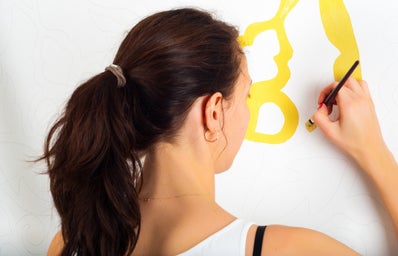Crafting is one of my favorite ways to spend my free time, which is unfortunate because I have very few, if any, artistic bones in my body. My Pinterest boards collect pins of beautiful DIY projects that look so easy – until I actually attempt them and give up when I realize that that super low-key paint chip calendar tutorial is likely missing a few, complicated steps.
These past failures did not deter me, however, when I ran across a mug that was so beautiful I immediately decided that I needed to make every single one of my friends and family one for the holidays. Marbled or watercolor mugs are usually made from cheap white mugs that have been dipped in nail polish to create a colorful, swirling pattern, like this:
I have both successfully made Sharpie mugs, where oil-based pens are used to draw a design on a blank cup, and marbled my own nails before, so I naively figured that combining the two processes would be a walk in the park. I recruited my best friend from home over break and we set out to replicate the Marbled Mug.
I’ll spare you the suspense: it did not end well.
My first “mistake” was choosing not to use nail polish. Nearly every tutorial I read said that the mugs probably weren’t safe to drink out of if the polish came near the top of the mug and that they definitely weren’t dishwasher safe. I wanted a more practical mug that could withstand washing, so I chose to attempt this tutorial that used acrylic paints instead of polish (acrylic paints still shouldn’t be used close to the top of the mug just to ensure that it’s safe to drink from). Here is a more traditional tutorial using polish for comparison.
I started with my fresh, blank mug and began zigzagging paint over the bottom as in the original tutorial.
Before
I blew the zigzags of paint across the bottom of the mug using a straw. At this stage, I think that the mug actually looked relatively decent.
In progress
I added another darker color to blend on top of the light pink I started with. At this point, the paint was getting pretty thick and started to conglomerate in certain areas. I decided to thin the purple paint a little and continue; however, this made the paint way too runny and it ended up getting all over the mug. It still didn’t look too bad, though, at least until it dried.
Thinner and runnier paint
This was, unfortunately, the finished product. It was a watercolor mug in an entirely different way than what I wanted:
Finished product.
The benefit to using acrylic paint was that water could wipe it right off. Thankfully, I was able to get rid of the mess and paint something much more simple.
What kind of DIY projects have you attempted?
Image Credits: Houseofhipsters.com, Hannah Bryan

